2001 CHRYSLER VOYAGER air condition
[x] Cancel search: air conditionPage 854 of 4284

Symptom:
OVERHEAD LIFTGATE/LOCKOUT SWITCHES OPEN
When Monitored and Set Condition:
OVERHEAD LIFTGATE/LOCKOUT SWITCHES OPEN
When Monitored: Whenever the BCM is awake.
Set Condition: When the BCM senses a overhead liftgate switch input that is greater
than 4.8 volts for over 10 seconds, this code will set.
POSSIBLE CAUSES
DTC PRESENT
SLIDING DOORS OVERHEAD SWITCH MUX CIRCUIT SHORT TO VOLTAGE
LIFTGATE SWITCH MUX WIRE OPEN
BODY CONTROL MODULE - OVERHEAD SWITCH OPEN
OVERHEAD SWITCH OPEN
TEST ACTION APPLICABILITY
1 With the DRBIIIt, record and erase DTC's.
Turn the ignition off, wait 10 seconds, then turn the ignition on.
Operate the power sliding door from the Overhead Console Switch.
With the DRBIIIt, read DTCs.
Does the DRBIIItdisplay OVERHEAD LIFTGATE/LOCKOUT SWITCHES OPEN?All
Ye s®Go To 2
No®Using the wiring diagram/schematic as a guide, inspect the
wiring and connectors for an intermittent condition.
Perform BODY VERIFICATION TEST - VER 1.
2 Disconnect the Body Control Module C3 connector.
Measure the voltage of the Sliding Doors Overhead Switch Mux circuit to ground.
Is there any voltage present?All
Ye s®Repair the Sliding Doors Overhead Switch Mux circuit for a short
to voltage.
Perform BODY VERIFICATION TEST - VER 1.
No®Go To 3
3 Disconnect the Body Control Module C2 connector.
Measure the resistance between ground and the Liftgate Switch Mux circuit.
Is the resistance below 25000.0 ohms?All
Ye s®Go To 4
No®Go To 5
4 If there are no possible causes remaining, view repair. All
Repair
Replace the Body Control Module.
Perform BODY VERIFICATION TEST - VER 1.
825
POWER DOORS - LIFTGATE
Page 856 of 4284

Symptom:
OVERHEAD LIFTGATE/LOCKOUT SWITCHES SHORT
When Monitored and Set Condition:
OVERHEAD LIFTGATE/LOCKOUT SWITCHES SHORT
When Monitored: Whenever the BCM is awake.
Set Condition: When the BCM senses a overhead liftgate switch input that drops to below
0.24 volts for over 10 seconds, this code will set.
POSSIBLE CAUSES
DTC PRESENT
OVERHEAD LIFTGATE SWITCH SHORTED
LIFTGATE SWITCH MUX WIRE SHORT TO GROUND
BODY CONTROL MODULE - OVERHEAD LIFTGATE SWITCH MUX SHORTED
TEST ACTION APPLICABILITY
1 With the DRBIIIt, record and erase DTC's.
Turn the ignition off, wait 10 seconds, then turn the ignition on.
Operate the Liftgate from the Overhead Console Switch.
With the DRBIIIt, read DTCs.
Does the DRBIIItdisplay OVERHEAD SWITCH #1 SHORT?All
Ye s®Go To 2
No®Using the wiring diagram/schematic as a guide, inspect the
wiring and connectors for an intermittent condition.
Perform BODY VERIFICATION TEST - VER 1.
2 With the DRBIIIt, erase DTCs.
Disconnect the Overhead Console Switch connector.
Turn the ignition off, wait 10 seconds, then turn the ignition on.
Wait 10 seconds.
With the DRBIIIt, read DTCs.
Does the DRBIIItdisplay OVERHEAD SWITCH #1 SHORT?All
No®Replace the Power Sliding Door Button Module.
Perform BODY VERIFICATION TEST - VER 1.
Ye s®Go To 3
3 Disconnect the Body Control Module C2 connector.
Disconnect the Overhead Console Switch connector.
Measure the resistance of the Liftgate Switch Mux circuit to ground.
Is the resistance below 500.0 ohms?All
Ye s®Repair the Liftgate Switch Mux wire for a short to ground.
Perform BODY VERIFICATION TEST - VER 1.
No®Replace the Body Control Module.
Perform BODY VERIFICATION TEST - VER 1.
827
POWER DOORS - LIFTGATE
Page 860 of 4284

Symptom:
PINCH SENSOR SIGNAL CIRCUIT SHORT TO GROUND
When Monitored and Set Condition:
PINCH SENSOR SIGNAL CIRCUIT SHORT TO GROUND
When Monitored: Whenever the Power Liftgate is operating.
Set Condition: The power liftgate module has detected the pinch sensor circuit voltage is
shorted to ground.
POSSIBLE CAUSES
DTC PRESENT
PINCH SENSOR SIGNAL CIRCUIT SHORT TO GROUND CIRCUIT
POWER LIFTGATE MODULE - SHORT TO GROUND
RIGHT PINCH SENSOR - SHORT TO GROUND
RIGHT PINCH SENSOR SIGNAL WIRE - SHORT TO GROUND
LEFT PINCH SENSOR - SHORT TO GROUND
RIGHT PINCH SENSOR SIGNAL WIRE SHORT TO GROUND
TEST ACTION APPLICABILITY
1 With the DRBIIIt, record and erase DTC's.
Turn the ignition off, wait 10 seconds, then turn the ignition on.
Operate the liftgate several times.
With the DRBIIIt, read DTCs.
Does the DRBIIItdisplay PINCH SENSOR CIRCUIT SHORT TO GROUND?All
Ye s®Go To 2
No®Using the wiring diagram/schematic as a guide, inspect the
wiring and connectors for an intermittent condition.
Perform BODY VERIFICATION TEST - VER 1.
2 Disconnect the Power Liftgate Module C2 connector.
Measure the resistance of the Pinch Sensor Signal circuit between the Pinch Sensor
Signal and the Ground circuits in the C2 connector.
Is the resistance below 20.0 ohms?All
Ye s®Repair the Pinch Sensor Signal circuit for a short to the Ground
circuit.
Perform BODY VERIFICATION TEST - VER 1.
No®Go To 3
3 Disconnect the Power Liftgate Module C2 connector.
Measure the resistance between ground and the Pinch Sensor Signal circuit.
Is the resistance below 100.0 ohms?All
Ye s®Go To 4
No®Replace the Power Liftgate Module.
Perform BODY VERIFICATION TEST - VER 1.
831
POWER DOORS - LIFTGATE
Page 865 of 4284
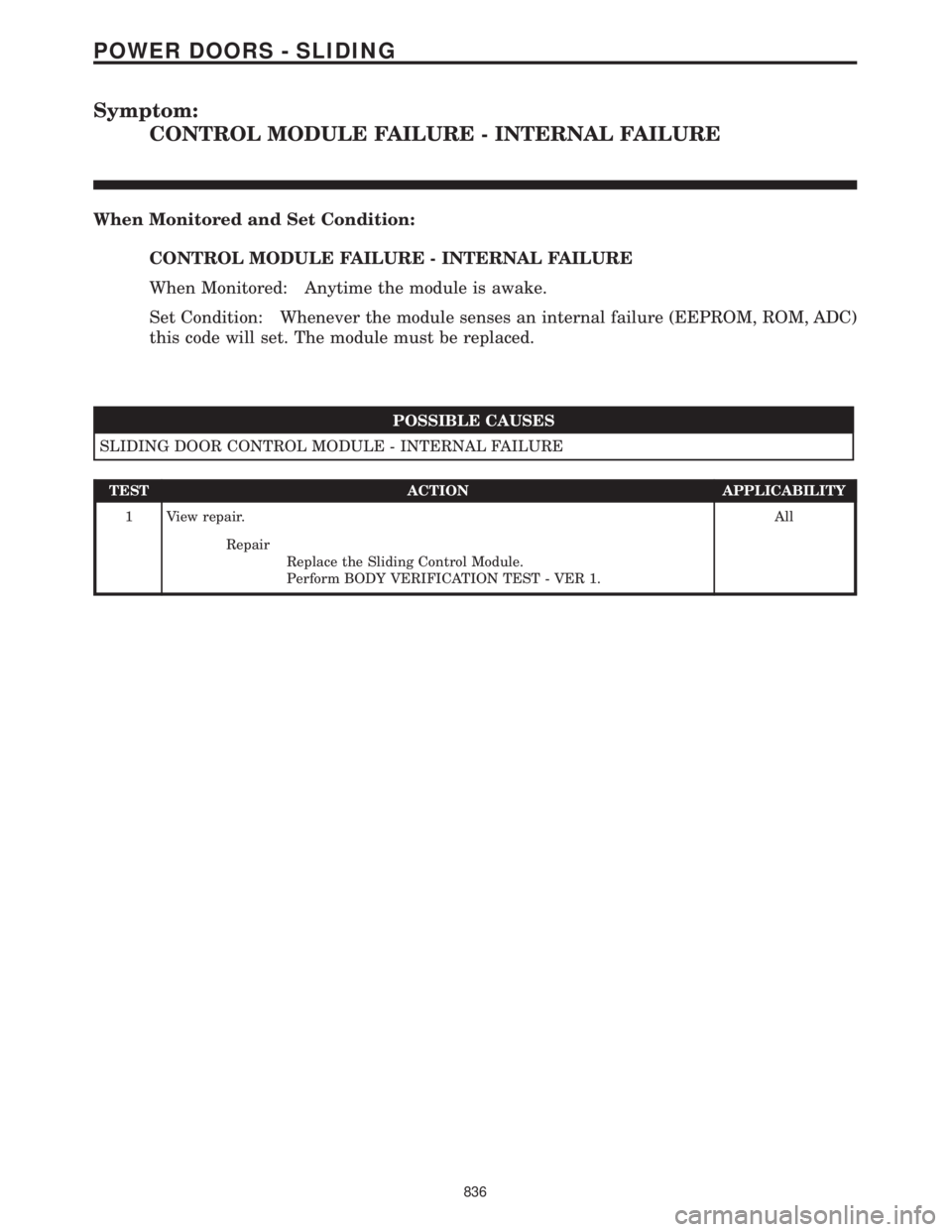
Symptom:
CONTROL MODULE FAILURE - INTERNAL FAILURE
When Monitored and Set Condition:
CONTROL MODULE FAILURE - INTERNAL FAILURE
When Monitored: Anytime the module is awake.
Set Condition: Whenever the module senses an internal failure (EEPROM, ROM, ADC)
this code will set. The module must be replaced.
POSSIBLE CAUSES
SLIDING DOOR CONTROL MODULE - INTERNAL FAILURE
TEST ACTION APPLICABILITY
1 View repair.All
Repair
Replace the Sliding Control Module.
Perform BODY VERIFICATION TEST - VER 1.
836
POWER DOORS - SLIDING
Page 867 of 4284
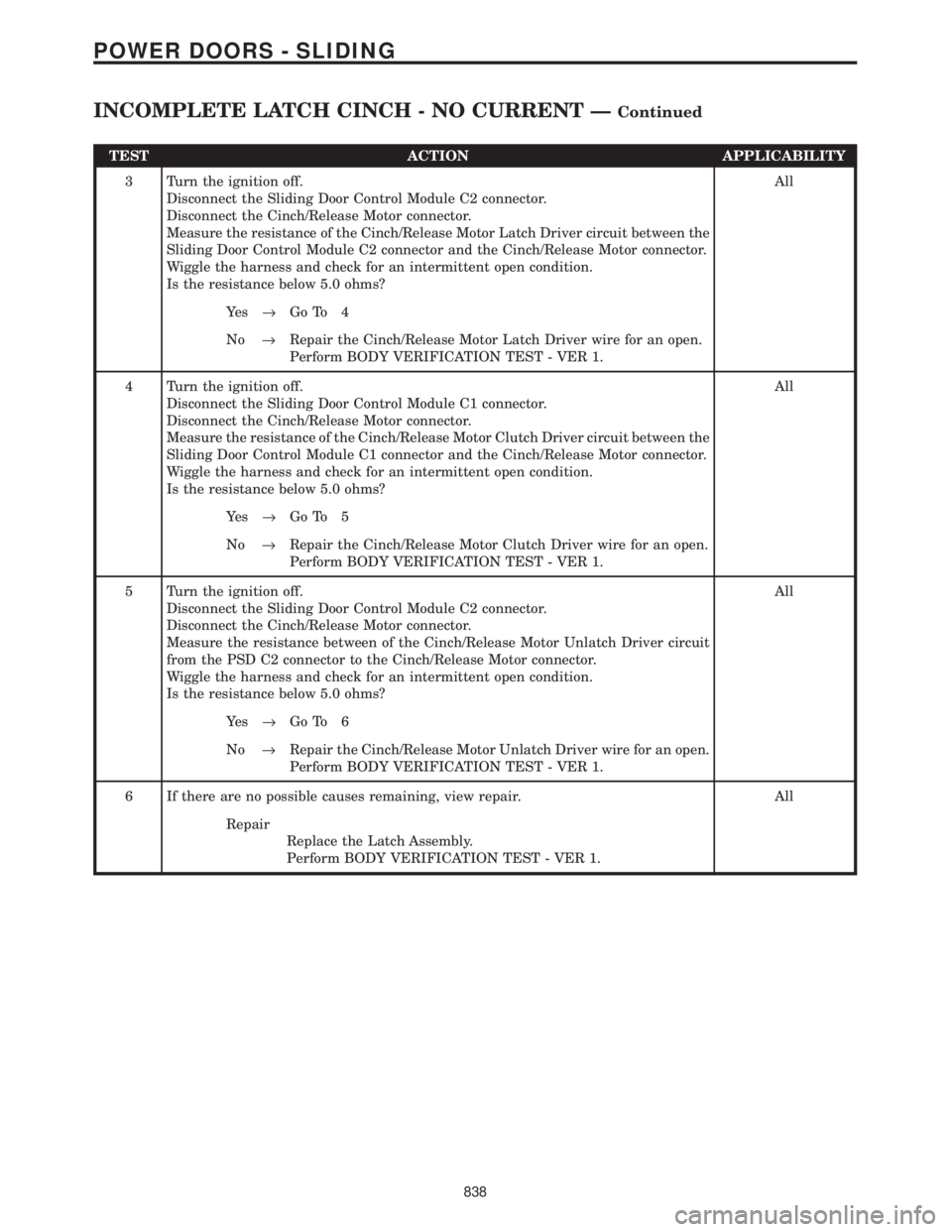
TEST ACTION APPLICABILITY
3 Turn the ignition off.
Disconnect the Sliding Door Control Module C2 connector.
Disconnect the Cinch/Release Motor connector.
Measure the resistance of the Cinch/Release Motor Latch Driver circuit between the
Sliding Door Control Module C2 connector and the Cinch/Release Motor connector.
Wiggle the harness and check for an intermittent open condition.
Is the resistance below 5.0 ohms?All
Ye s®Go To 4
No®Repair the Cinch/Release Motor Latch Driver wire for an open.
Perform BODY VERIFICATION TEST - VER 1.
4 Turn the ignition off.
Disconnect the Sliding Door Control Module C1 connector.
Disconnect the Cinch/Release Motor connector.
Measure the resistance of the Cinch/Release Motor Clutch Driver circuit between the
Sliding Door Control Module C1 connector and the Cinch/Release Motor connector.
Wiggle the harness and check for an intermittent open condition.
Is the resistance below 5.0 ohms?All
Ye s®Go To 5
No®Repair the Cinch/Release Motor Clutch Driver wire for an open.
Perform BODY VERIFICATION TEST - VER 1.
5 Turn the ignition off.
Disconnect the Sliding Door Control Module C2 connector.
Disconnect the Cinch/Release Motor connector.
Measure the resistance between of the Cinch/Release Motor Unlatch Driver circuit
from the PSD C2 connector to the Cinch/Release Motor connector.
Wiggle the harness and check for an intermittent open condition.
Is the resistance below 5.0 ohms?All
Ye s®Go To 6
No®Repair the Cinch/Release Motor Unlatch Driver wire for an open.
Perform BODY VERIFICATION TEST - VER 1.
6 If there are no possible causes remaining, view repair. All
Repair
Replace the Latch Assembly.
Perform BODY VERIFICATION TEST - VER 1.
838
POWER DOORS - SLIDING
INCOMPLETE LATCH CINCH - NO CURRENT ÐContinued
Page 871 of 4284
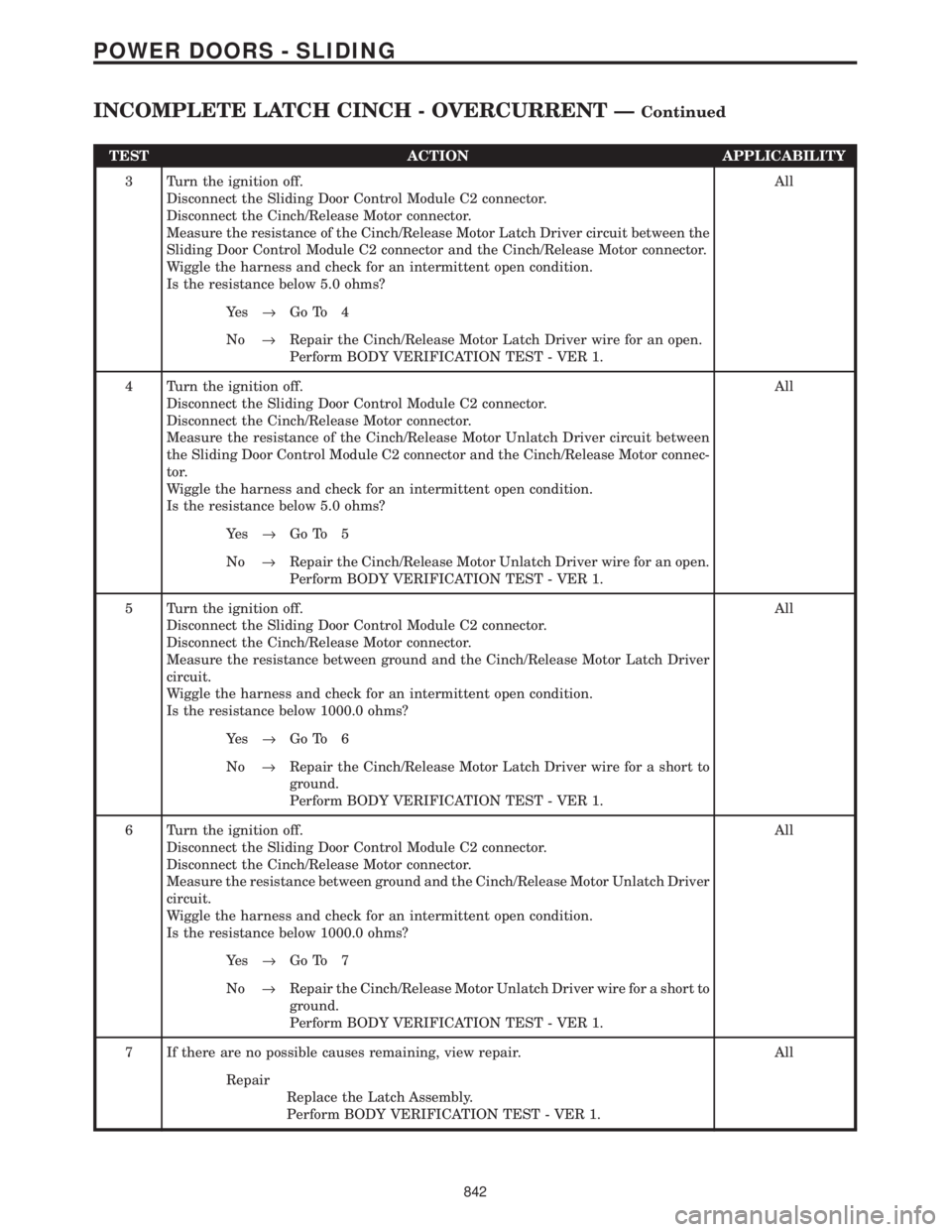
TEST ACTION APPLICABILITY
3 Turn the ignition off.
Disconnect the Sliding Door Control Module C2 connector.
Disconnect the Cinch/Release Motor connector.
Measure the resistance of the Cinch/Release Motor Latch Driver circuit between the
Sliding Door Control Module C2 connector and the Cinch/Release Motor connector.
Wiggle the harness and check for an intermittent open condition.
Is the resistance below 5.0 ohms?All
Ye s®Go To 4
No®Repair the Cinch/Release Motor Latch Driver wire for an open.
Perform BODY VERIFICATION TEST - VER 1.
4 Turn the ignition off.
Disconnect the Sliding Door Control Module C2 connector.
Disconnect the Cinch/Release Motor connector.
Measure the resistance of the Cinch/Release Motor Unlatch Driver circuit between
the Sliding Door Control Module C2 connector and the Cinch/Release Motor connec-
tor.
Wiggle the harness and check for an intermittent open condition.
Is the resistance below 5.0 ohms?All
Ye s®Go To 5
No®Repair the Cinch/Release Motor Unlatch Driver wire for an open.
Perform BODY VERIFICATION TEST - VER 1.
5 Turn the ignition off.
Disconnect the Sliding Door Control Module C2 connector.
Disconnect the Cinch/Release Motor connector.
Measure the resistance between ground and the Cinch/Release Motor Latch Driver
circuit.
Wiggle the harness and check for an intermittent open condition.
Is the resistance below 1000.0 ohms?All
Ye s®Go To 6
No®Repair the Cinch/Release Motor Latch Driver wire for a short to
ground.
Perform BODY VERIFICATION TEST - VER 1.
6 Turn the ignition off.
Disconnect the Sliding Door Control Module C2 connector.
Disconnect the Cinch/Release Motor connector.
Measure the resistance between ground and the Cinch/Release Motor Unlatch Driver
circuit.
Wiggle the harness and check for an intermittent open condition.
Is the resistance below 1000.0 ohms?All
Ye s®Go To 7
No®Repair the Cinch/Release Motor Unlatch Driver wire for a short to
ground.
Perform BODY VERIFICATION TEST - VER 1.
7 If there are no possible causes remaining, view repair. All
Repair
Replace the Latch Assembly.
Perform BODY VERIFICATION TEST - VER 1.
842
POWER DOORS - SLIDING
INCOMPLETE LATCH CINCH - OVERCURRENT ÐContinued
Page 873 of 4284
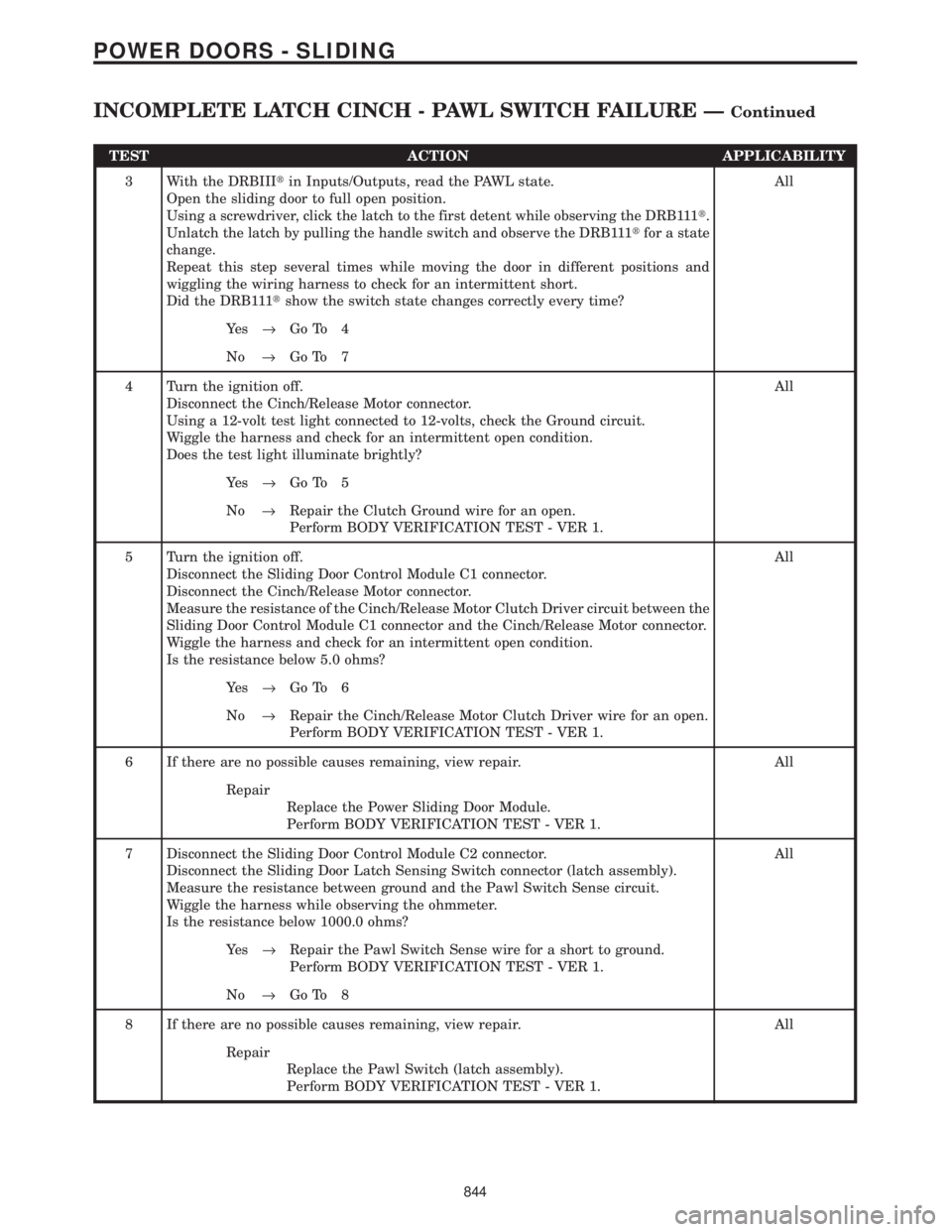
TEST ACTION APPLICABILITY
3 With the DRBIIItin Inputs/Outputs, read the PAWL state.
Open the sliding door to full open position.
Using a screwdriver, click the latch to the first detent while observing the DRB111t.
Unlatch the latch by pulling the handle switch and observe the DRB111tfor a state
change.
Repeat this step several times while moving the door in different positions and
wiggling the wiring harness to check for an intermittent short.
Did the DRB111tshow the switch state changes correctly every time?All
Ye s®Go To 4
No®Go To 7
4 Turn the ignition off.
Disconnect the Cinch/Release Motor connector.
Using a 12-volt test light connected to 12-volts, check the Ground circuit.
Wiggle the harness and check for an intermittent open condition.
Does the test light illuminate brightly?All
Ye s®Go To 5
No®Repair the Clutch Ground wire for an open.
Perform BODY VERIFICATION TEST - VER 1.
5 Turn the ignition off.
Disconnect the Sliding Door Control Module C1 connector.
Disconnect the Cinch/Release Motor connector.
Measure the resistance of the Cinch/Release Motor Clutch Driver circuit between the
Sliding Door Control Module C1 connector and the Cinch/Release Motor connector.
Wiggle the harness and check for an intermittent open condition.
Is the resistance below 5.0 ohms?All
Ye s®Go To 6
No®Repair the Cinch/Release Motor Clutch Driver wire for an open.
Perform BODY VERIFICATION TEST - VER 1.
6 If there are no possible causes remaining, view repair. All
Repair
Replace the Power Sliding Door Module.
Perform BODY VERIFICATION TEST - VER 1.
7 Disconnect the Sliding Door Control Module C2 connector.
Disconnect the Sliding Door Latch Sensing Switch connector (latch assembly).
Measure the resistance between ground and the Pawl Switch Sense circuit.
Wiggle the harness while observing the ohmmeter.
Is the resistance below 1000.0 ohms?All
Ye s®Repair the Pawl Switch Sense wire for a short to ground.
Perform BODY VERIFICATION TEST - VER 1.
No®Go To 8
8 If there are no possible causes remaining, view repair. All
Repair
Replace the Pawl Switch (latch assembly).
Perform BODY VERIFICATION TEST - VER 1.
844
POWER DOORS - SLIDING
INCOMPLETE LATCH CINCH - PAWL SWITCH FAILURE ÐContinued
Page 875 of 4284
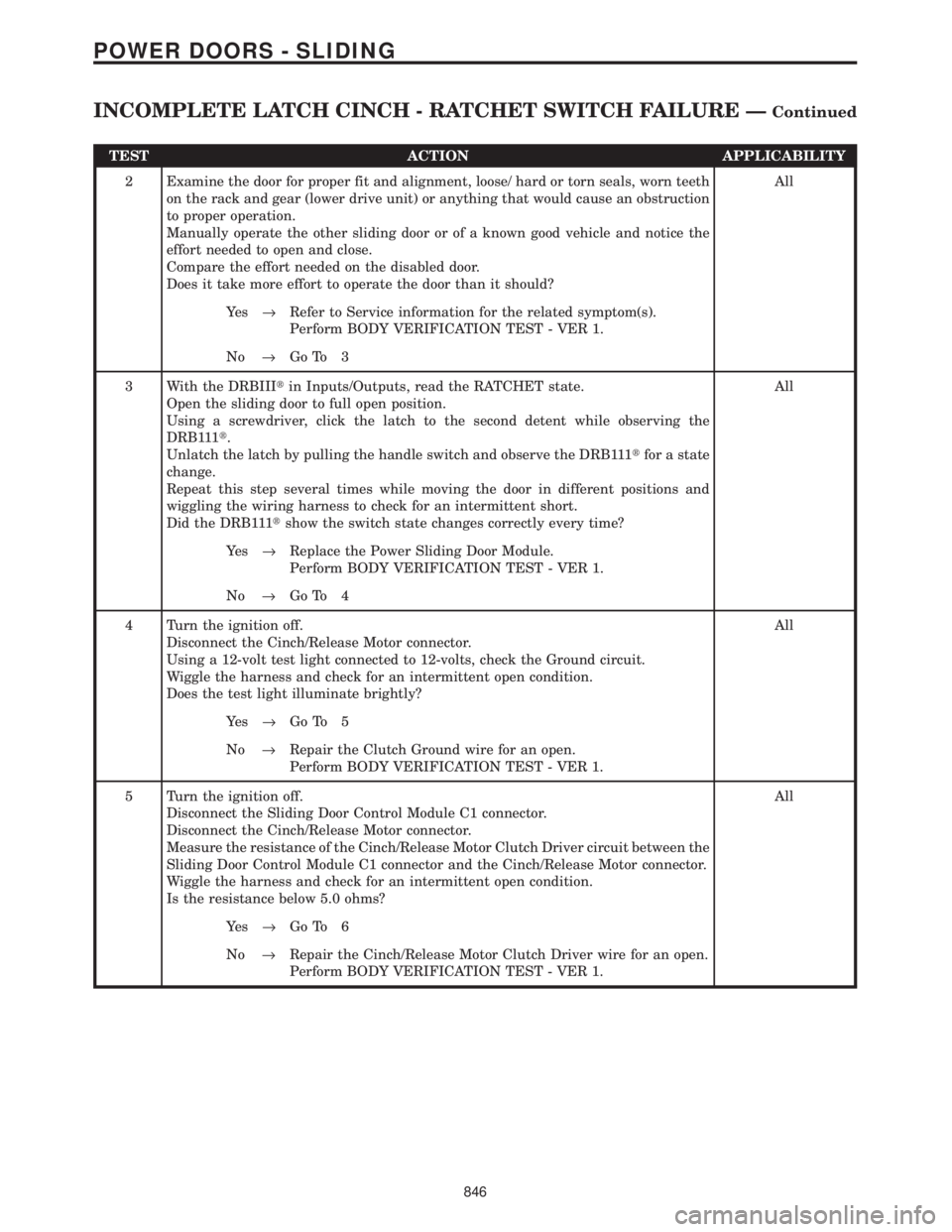
TEST ACTION APPLICABILITY
2 Examine the door for proper fit and alignment, loose/ hard or torn seals, worn teeth
on the rack and gear (lower drive unit) or anything that would cause an obstruction
to proper operation.
Manually operate the other sliding door or of a known good vehicle and notice the
effort needed to open and close.
Compare the effort needed on the disabled door.
Does it take more effort to operate the door than it should?All
Ye s®Refer to Service information for the related symptom(s).
Perform BODY VERIFICATION TEST - VER 1.
No®Go To 3
3 With the DRBIIItin Inputs/Outputs, read the RATCHET state.
Open the sliding door to full open position.
Using a screwdriver, click the latch to the second detent while observing the
DRB111t.
Unlatch the latch by pulling the handle switch and observe the DRB111tfor a state
change.
Repeat this step several times while moving the door in different positions and
wiggling the wiring harness to check for an intermittent short.
Did the DRB111tshow the switch state changes correctly every time?All
Ye s®Replace the Power Sliding Door Module.
Perform BODY VERIFICATION TEST - VER 1.
No®Go To 4
4 Turn the ignition off.
Disconnect the Cinch/Release Motor connector.
Using a 12-volt test light connected to 12-volts, check the Ground circuit.
Wiggle the harness and check for an intermittent open condition.
Does the test light illuminate brightly?All
Ye s®Go To 5
No®Repair the Clutch Ground wire for an open.
Perform BODY VERIFICATION TEST - VER 1.
5 Turn the ignition off.
Disconnect the Sliding Door Control Module C1 connector.
Disconnect the Cinch/Release Motor connector.
Measure the resistance of the Cinch/Release Motor Clutch Driver circuit between the
Sliding Door Control Module C1 connector and the Cinch/Release Motor connector.
Wiggle the harness and check for an intermittent open condition.
Is the resistance below 5.0 ohms?All
Ye s®Go To 6
No®Repair the Cinch/Release Motor Clutch Driver wire for an open.
Perform BODY VERIFICATION TEST - VER 1.
846
POWER DOORS - SLIDING
INCOMPLETE LATCH CINCH - RATCHET SWITCH FAILURE ÐContinued